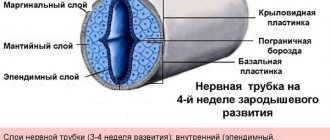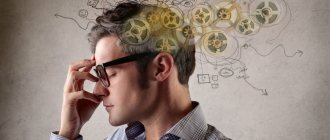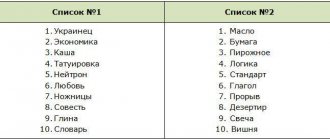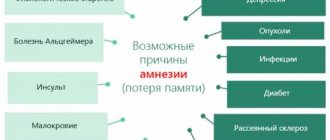Nikolay Frantsuzov, neuropsychologist and researcher at Vikium, spoke especially for Netology about memory problems and ways to develop it in people of different professions: designers, marketers, analysts.
It is known that temporary neural connections that are formed in the cerebral cortex can persist for many years and decades. If they are reinforced from time to time or renewed, these communications are preserved forever.
Training program: “Big Data: basics of working with large amounts of data”
A person is under the influence of various harmful factors that have a negative impact. This leads to a decrease in mental and creative activity, especially in professional activities. First, memory functions decline. It becomes more difficult to recall significant information, remember large volumes of new material, repeatedly reproduce what you already know, and operate with the knowledge available to us. It all ends with a lack of flexibility of thinking and creativity.
Break the whole into parts
It is easier for the brain to remember an image in parts rather than as a whole - take advantage of this and divide the image into several separate fragments. It will be much easier to record each of them and then put them together into a single picture. This technique has long been used for tasks that require the participation of visual memory - for example, if you need to remember a map. Future translators from Chinese in the first stages of training often encounter difficulties in memorizing hieroglyphs. To make their task easier, teachers explain that all hieroglyphs have the same signs, combined in different ways - having learned these details, it will be much easier to remember the hieroglyphs themselves.
In the same way, you can fix in memory images made up of similar components. For example, how a person is dressed. This information can be divided into three “zones” - head, torso and legs. Hairstyle or headdress on the head; the torso can be dressed in one item (coat or dress), or maybe two (sweater and jeans); in any case, the legs are wearing something (sneakers, boots, shoes). Now we remember the color combination of all these details - and you’re done, you can’t go wrong. This method works well when you need to remember people you meet for the first time - for example, in line at the clinic.
Visualization of the image
You need any bright object. It can be anything you can get your hands on. The main thing is something bright (toy, fruit, book, etc.). Consider the item you have chosen in detail and within a few minutes. Pay attention to every line or scratch. Then just close your eyes and try to visualize the object. Make it as clear as possible and open your eyes. All that remains is to compare the mental and real objects. Repeat this exercise until both objects are completely the same. Then take another item.
Develop synesthetic perception
What does a sunny day smell like? What is the sound of this high-rise building? What does red taste like? This is not just a game - in this way you develop a connection between visual images and the sensations of all other senses. Synesthesia helps the brain inventing complex associative connections: with their participation, it will be easier to find the necessary data in memory. Thanks to synesthesia, visual images are firmly fixed in the mind - one sensory perception system triggers the mechanisms of another. By the way, this property of the human brain has long been noticed and actively used, which is why metro lines differ not only in destinations, but also in colors. Most people find it easier to remember a color, smell or taste than a name, which is why all brands have their own recognizable colors. Through the development of synesthesia, you also include your creative talents - many brilliant creators from the world of art had this useful property.
Diagnostics
To find out whether your visual memory is good or bad, a special diagnosis is carried out in the form of a test. The subject is presented with several pictures, which he must remember and then describe. The number of illustrations and their complexity depends on age.
Diagnosis of celiac disease in children
Test for older preschoolers and primary schools “10 pictures”.
Objective: to assess the level of development of mental health in a 6-9 year old child.
Equipment: 10 illustrations. They can be designed in the form of a notebook or all 10 placed on one sheet.
Illustrations:
- Mushroom.
- Checkbox.
- Butterfly.
- Ball.
- Snowflake.
- Umbrella.
- Fish.
- Flower.
- Sun.
- Car.
Instructions:
- Set a task for your child to remember as many pictures as possible.
- Show illustrations. If they are placed on one sheet, give them 15 seconds to study them. If in book form - 25.
- Remove pictures from his field of vision.
- Ask them to name what was depicted on them. Kids can be asked to draw from memory.
Evaluation of results:
- high level of development of salary - 8-10 pictures,
- average - 4-7,
- low - 3 or less.
Diagnosis of celiac disease in adults
Test for teenagers and adults “Two-part illustrations”.
Objective: study of visual memory, assessment of its level in people over 13 years of age.
Equipment: two series of illustrations. Each includes 30 pictures with various objects (not plot ones). They should be connected with paper clips like a desk calendar or notepad.
Instructions:
- Set a task - remember as many illustrations as possible.
- Flip through the notebook, lingering on each picture for no more than 2 seconds.
- When the pictures of the first series are over, after 10 seconds ask the subject to name the objects that he was able to remember. The answers are recorded. The sequence does not matter, the main thing is the amount of information reproduced.
- The illustrations of the second series are shown in exactly the same way, but the next day.
Checking and evaluating the results: the average number of memorized pictures over 2 days is calculated, and the level of development of the GP is determined:
- good visual memory - 18-30 pictures,
- average – 11-17 pictures,
- bad - less than 10.
In order to find out your own level of development of mental health, you can take numerous online tests. If the child has it, it is advisable to consult a psychologist. If the results are not very good, you need to set the goal to develop visual memory as much as possible.
Copy asymmetrical designs
Visual images that can be logically explained are best imprinted in memory. And vice versa - the less meaning there is in the image, the more difficult it is to reproduce. Because of this, many travelers easily find their way around modern cities with a clear structure and immediately get lost in ancient centers with a lack of logic in the layout of streets. There is an excellent exercise that has a very strong effect on the development of visual memory. It is not easy, so it is better to master it in childhood. To do this, you will need a stone with a network of veins - marble or malachite. Of course, it is not so easy to get these minerals, so you can use photographs of them. Arm yourself with pencils and draw a “portrait from life,” trying to reproduce all the veins, color transitions, thickness and location of the lines relative to each other. Then take a new piece of paper and try to repeat it from memory. Most likely, you won’t succeed right away; you will need to try again and again to make the copy even remotely match the original.
IQClub will help you develop your memory
The modern rhythm of life requires constant concentration. This also applies to our children. Educational games on the IQClub website will help them develop the necessary skills, including a good memory. A team of professionals prepared games for the children, taking into account their age. Experienced teachers, psychologists, and speech therapists worked on the content. Parents will be satisfied with the useful leisure time of their child.
To use the service, you need:
- Register in the system (via social networks).
- Your child takes a fun test.
- A special program evaluates its strengths and weaknesses.
- An individual training plan is formed.
- Your child can play educational games wherever there is Internet access.
The IQClub portal has developed special games for children from 3 to 14 years old. They are aimed at developing erudition, creative thinking, and helping to increase vocabulary. Students are helped in their studies.
Turn images into words
Many people with poor visual memory can compensate for this deficiency by being able to remember words well in a certain order. Our brains are great at replacing images with symbols. Having broken the image into details, it is enough to simply give them a verbal description, preferably with a lot of detail. For example, you saw a person only once, and now you have to meet him again among a large crowd of people. To avoid embarrassment, you need to imagine that you are describing him to compile an identikit: “Above average height, thin, wiry, dark hair, cut short, dark eyes, wide eyebrows. The nose is large, with a hump. He squints." Converting a visual image into verbal symbols will help you flesh out details that you wouldn’t pay attention to during a quick acquaintance with a new friend. When going to a meeting, you will simply recite his verbal portrait to yourself, and the brain itself will reproduce the visual picture.
Kinds
According to the generally accepted classification, the following types of visual memory are distinguished in psychology.
- In terms of the duration of preservation and consolidation of the material, it can be both short-term (the moment of fixing the picture) and long-term (memorizing it for a long time).
- According to goal setting: involuntary, voluntary.
- By method of memorization: logical, mechanical.
In addition to the general classification among visual memory, there are:
- sensory - a phenomenon that was discovered not so long ago: memorizing a picture occurs at the moment when a person blinks,
- eidetic - a combination of visual images (they are the basis), auditory, gustatory, tactile,
- spatial - good orientation on the terrain, when all the features of the route are remembered to the smallest detail.
Regarding the nature of mental activity that predominates in activity, some psychologists distinguish such mixed subtypes of memory as visual-motor, visual-emotional and visual-semantic. This classification once again emphasizes the fact that visualization is involved in any recording and reproduction of material.
Pay attention to details
When the brain is not faced with the task of remembering some elements of the picture it sees, it does not strain. To bring the ability to notice details to automaticity, you need to practice. What was the colleague you met on the street wearing? How did you gesture? What was the background like behind him - the street, the kiosks, the trees? How many and what did you notice? How are the items arranged? By training your brain in this way, you will quickly teach it to remember the situation and minor details of the events that happened to you. The main thing is not to let him “hack” by creating fictitious details - to avoid this, return to the place and compare the features of the surroundings with what you remember.
original source https://constructorus.ru/
Share on social networks
RќСЂР°РІРёС‚СЃСЏ
Arbitrary memory
The essence of this type of memory is to remember some information specifically, to learn what is necessary. A lot of research and experiments have also been devoted to voluntary memory. From a psychological point of view, this type of memory is a process that is carried out thanks to the control of consciousness. This goal is achieved through setting certain goals, using special methods, and applying effort. Simply put, when we have a goal to remember some information, we set this goal consciously and make some effort to achieve it. Voluntary memory plays an important role in the normal functioning of every person, as it helps in the implementation of any activity, in the process of development, self-improvement, personality formation, and so on. It works according to the following principle: initially, a specific goal is set to remember, to leave some information in the head, which will later need to be reproduced as acquired knowledge, skills acquired earlier. Of all the types of memory that an individual possesses, it is voluntary that is considered the most productive.
Educational games for memory
Game 1 “Numeric Reach Revolution”
The game "Numeric Span Revolution" develops memory.
The main point of the game is to remember the numbers on the screen and dial them correctly.
In this game, numbers are displayed on the screen for a few seconds, these numbers must be remembered, then you must enter these numbers in an empty window in order. Look carefully at what numbers will be on the screen, first two numbers are displayed in order, then three numbers , then four numbers, then again there may be two numbers. Below the picture there is a board with numbers, using the mouse, you can click the numbers you need. If you remember the numbers correctly, then continue to play and score points, but if you remember three times If the numbers are not entered correctly, the game ends.
Play now
Game 2 “Fast addition reload”
The game “Fast addition reboot” develops thinking, memory and attention.
The main point of the game is to choose the correct terms, the sum of which will be equal to the given number.
In this game, at the top of the screen the task is written: add a number and the number is indicated. Below are three more numbers. You need to add the sum of these three numbers to get the given number. The game starts with a prime number and with each subsequent game this number increases, first the count goes to twenty, then to thirty and so on. Using the mouse, you can click on the selected numbers and answer. If you answered correctly, then you continue to score points and play further.
Play now
Game 3 "Letter Span"
The game “Letter Span” develops memory and attention.
The main point of the game is to remember the letters and write them correctly.
In this game, there is a black scoreboard on the screen; on this scoreboard, different letters are displayed for a few seconds, you need to remember these letters and when the letters disappear write them on the black scoreboard. The letters are located at the bottom of the screen, use the mouse to click on the desired letters and they will appear on the black scoreboard. The game starts with fewer letters, first two letters appear on the screen, then three letters, then four and so on. If you answered correctly, then you continue to score points and play further.
Play now
Game 4 "Number 3 back"
The game “Number 3 Backwards” develops memory.
The main essence of the game is to remember the sequence of numbers and compare the number on the last card with the previous card.
In this game, cards with numbers are given on the screen, the numbers on the cards open for a few seconds, then disappear and other numbers appear. You must remember the entire sequence of numbers that was shown on the screen and compare the number of the last card with the previous card. Read the question on the screen carefully. At the bottom of the screen there are two buttons “yes” and “no”. Using the mouse, you can press the button you need. If you answered correctly, then you continue to score points and play further.
Play now
Game 5 "Diamonds"
The game "Diamonds" develops memory.
The main essence of the game is to remember the order of the figures that light up on the screen and repeat it.
There are figures on the screen, they light up one by one, you need to remember the order in which these figures light up, and repeat it. With each subsequent stage of the game, the game becomes more complicated, new figures are added in larger quantities. Watch carefully the order in which the figures are lit. Using the mouse or keyboard, you can click through all the figures in order. If you answered correctly, then you continue to score points and play further.
Play now
Game 6 "Speed Comparison"
The game "Speed Comparison" develops memory and attention.
The main point of the game is to remember the previous item and compare it with the current one on the screen.
In this game, an item is displayed on the screen for a few seconds, you need to remember this item and compare it with the next item. At the bottom of the game there are two buttons "yes" and "no". Using the mouse, you can select the correct answer and click on it. If the item is the same, then you answer “yes,” if the items are different, you answer “no.” The game will end if you answer incorrectly three times. If you answered correctly, then you continue to collect points and play further.
Play now
Game 7 “Complicated high-speed movement”
The game “Complicated high-speed movement” develops memory and attention.
The main point of the game is to remember the previous item and compare it with the current one on the screen.
In this game, a drawing is displayed on the screen for a few seconds, you need to remember this drawing and compare it with the next object. At the bottom of the screen there are three buttons “yes” “no” “partially matches”. If the object is the same then you answer “yes”, if the objects are different you answer “no”, if the objects are similar you answer “partially matches”. This game is designed to increase speed .If you answer incorrectly three times, the game ends. If you answer correctly, you continue to score points and play further.
Play now
Game 8 “Memorize and call”
The game “Memorize and Call” develops memory and attention.
The main point of the game is to remember the numbers in the table and call them in ascending order.
In this game, a table with numbers is given, first the numbers are shown on the screen for a few seconds, you need to remember them, then the numbers are closed. Remember where the smallest number is located and click this cell, then click the cell where the next number goes in ascending order. With each subsequent game, the table will increase and there will also be more numbers in it. Look carefully at the order of the numbers. You can answer using the mouse by clicking on the desired cell. If you answered correctly, then you continue to score points and play further.
Play now
Game 9 “Number Reach”
The game "Number Span" develops memory and attention.
The main point of the game is to remember the previous number and compare it with the current one on the screen.
In this game, numbers appear on the screen for a few seconds; you must remember them. At the bottom of the screen there are numbers from 0 to 9. Using the mouse, you can click the numbers you need. The game starts with two numbers, then the numbers become three, four and so on, the more you play, the more difficult the game becomes. If you typed the numbers correctly, then move on to play and score points, but if you get the numbers wrong three times, the game ends.
Play now
Game 10 "Spatial speed comparison"
The game “Spatial Speed Comparison” develops memory and attention.
The main essence of the game is a series of drawings on the screen; you need to compare them with the previous drawing and answer whether it is repeated or not.
In this game, a figure appears on the screen for a few seconds, you need to remember it, then it disappears and another figure appears. Compare the figure on the screen with the previous figure. At the bottom of the screen there are two buttons “yes” and “no”. You can answer using the mouse by clicking on the desired button. If you answer correctly, then you continue to gain points and play further.
Play now
Formation and development of memory
What is meant by the formation and development of memory.
When discussing the types of human memory, we said that a person has some of them from birth, others appear in him during life. But both types of memory, congenital and acquired, change during life. In this regard, it makes sense to discuss the issue of the formation and development of human memory in general.
When they talk about the formation of memory, they mean the process of its emergence and formation, that is, the achievement of a certain level of maturity by those types of memory that are not given to a person from birth, for example, voluntary, mediated and logical memory. When we talk about the development of memory, this is understood as the process of further improvement of those types of memory that a person already has and which, by the time in question, have reached a certain level of maturity.
But all this represents only sophisticated reasoning about terms, about their content, which is embedded in these terms by conceptually exact science. In fact, the formation and development of all types of human memory occurs simultaneously, and it is not possible to separate these two processes.
Conventionally, we can talk about the formation of memory when a person does not yet have a certain type of memory or already has it, but this type of memory is relatively poorly developed. Memory formation is considered incomplete if the memory does not reach the level that characterizes the average adult, or the “average” person of the subject’s age. For example, the memory of a 6-year-old child is still being formed if this child has less developed memory than most other children of his age.
Typically, memory formation occurs in childhood, and its development occurs at a later age.
In what directions is a person’s memory formed and developed?
There are two such general directions: phylogenetic and ontogenetic.
The phylogenetic
direction of the formation and development of memory is a process of progressive change in people's memory throughout human history.
The ontogenetic
direction of the formation and development of memory concerns the positive changes that occur in the memory of an individual person during his life.
Once upon a time, in times distant from us, when man had just begun to stand out among animals by his appearance, psychology, way of life and culture, his memory was not much different from the memory of animals. He possessed only involuntary, immediate and mechanical memory.
In the process of historical development, people acquired new types of memory and significantly improved them. This process is actively continuing at the present time. The higher the level of socio-cultural and economic development a society is, the more developed the memory of the past seems to be among the people who make up this society, and the more of their past people strive to preserve and pass on to future generations.
In approximately the same position in which all of humanity once found itself, an individual person is at the moment of birth regarding the development of his memory. He has only those elementary mnemonic abilities that are given to him as a biological organism by nature. They are clearly not enough for a person to acquire the knowledge, skills and abilities necessary for life in modern society. There is too much of this knowledge, skills and abilities, and they are too complex to master using only natural memory.
Therefore, from childhood, even before the moment when he begins targeted learning at school, new, more productive types of memory are formed. They must not only be constantly maintained throughout life, but also continuously improved, since modern man needs to replenish his knowledge and skills. All this concerns the ontogenetic development of memory.
When the ontogeny of human memory is considered separately, it distinguishes the processes of formation and development of individual types of memory, the processes of interaction of different types of memory with each other during their formation and development. In addition, each person has individual memory characteristics. Therefore, the ontogenesis of the memory of each individual person is also of interest to psychologists. For example, some people may have a well-developed visual memory since childhood, while others may have an auditory memory. It can be interesting to trace the process of their formation, development, influence not only on other types of memory, but also on the psyche and behavior of a person as a whole.
How human memory was formed and developed in phylogenesis.
The formation and development of human memory in phylogenesis, as well as its transformation in ontogenesis, apparently proceeded in different directions. We have already noted one of these areas: the emergence and development of new, socially conditioned types of memory in people. The second direction was associated with the invention and improvement of mnemonic technical means. Once upon a time, in the early stages of human development, people began to speak, and the meanings of words began to be recorded, passed on from generation to generation, memory-information accumulated by previous generations of people.
Then people invented writing and, in the form of written texts, began to pass on the accumulated knowledge from generation to generation. The process of improving mnemonic tools has been especially active over the past two centuries. In the 19th and 20th centuries. people have invented and improved various means of technical recording, storage and reproduction of information. As a result, the speed and duration of recording storage, the speed and quality of reproduction and transmission of information have increased significantly.
But in phylogenesis, another interesting process of transformation of people’s memory took place. It concerns the inclusion of other mental functions of a person in memory processes in order to improve them. This development process was studied and presented by the domestic psychologist P. P. Blonsky.
He expressed and substantiated the hypothesis that in phylogenesis the following types of memory successively appeared in people, complementing each other:
motor, affective, figurative
and
logical.
Motor memory is the memory for a variety of movements, in particular those associated with various types of professional and work activities of a person. Affective memory is called memory for emotional experiences. Figurative memory is understood as memory that stores and transmits visual, auditory and other images from generation to generation. This is, for example, memory associated with various figurative ideas, works of art, literature, etc. Logical memory includes mnemonic processes relating to thoughts, ideas, and inferences.
First, according to Blonsky, at the dawn of humanity, motor memory appeared and began to develop in people. This probably happened in those distant times from us, when labor became a special activity of people and they came up with tools. The use of these tools and productive labor itself required people to master, memorize, and pass on from generation to generation special movements, skills and abilities associated with the use of appropriate tools and instruments. Almost simultaneously with this, people developed speech, and they needed to preserve and transmit from generation to generation information about significant life experiences, in particular those emotions that are associated with satisfying basic life needs and ensuring a person’s safe existence. This is how affective memory emerged.
Following this, people began to develop figurative memory. The need for its emergence was dictated by the need for the development of arts, which are based on the figurative ideas of people and which can be transmitted from generation to generation only in figurative form.
The last thing in the history of mankind to arise and begin to develop is logical memory. Its formation and development is closely related to the emergence of scientific knowledge, which can be preserved and transmitted from generation to generation in the form of ideas. This type of memory has received special development among people, since it turned out to be associated with the development of thinking, on which the progress of mankind depends.
What is the formation and development of human memory in ontogenesis.
The most interesting stage in the ontogenesis of human memory is his childhood. At this time, the main processes associated with changes in people’s memory occur, therefore the formation and development of human memory in childhood has attracted the greatest attention of psychologists.
A. N. Leontiev studied this process in detail
In his scientific research, he was guided by the general theory of the cultural and historical development of higher mental functions
of L. S. Vygotsky
and was specifically interested in how children develop natural and socially conditioned types of memory, in particular mechanical, involuntary and immediate memory, on the one hand, logical , voluntary and mediated memory, on the other hand.
In a study conducted by A.N. Leontyev, children of different ages and students were taken as subjects. The age of the subjects varied from 4-5 years (preschoolers) to 18-20 years (students). In a group of subjects of each age, the productivity of natural and socially conditioned types of memory was studied separately. Accordingly, conclusions were drawn about the comparative productivity of various types of memory at different ages and about the dynamics of their development during the transition from age to age. In the course of the study, the results shown in Fig. 1 were obtained. 2.
Rice. 2
At preschool age (4-5 years), all types of memory of a child are still very poorly developed, and the productivity of natural and socially conditioned types of memory is approximately the same. At the same time, this age apparently represents the initial stage of development in a child of socially determined types of memory: voluntary, indirect and logical.
By the time children enter school, their memory is already sufficiently developed to successfully assimilate the material of the school curriculum to the extent that it is given in a regular secondary school. At this time, an important trend is emerging in the development of all types of memory, which remains unchanged throughout schooling: an advantage in the functioning and accelerated development of natural types of memory in children. These types of memory in their productivity in childhood are significantly superior to socially determined types of memory throughout all years of children’s schooling. Children of all school ages remember educational material much better through involuntary, immediate and mechanical memory than through voluntary, indirect and logical memory. There are, however, certain age differences in this regard between children. From primary school age to adolescence, the productivity of natural types of memory in children grows faster than the productivity of socially conditioned types of memory, and the difference between them reaches its maximum precisely in adolescence. Further, the development trend of the types of memory under discussion changes: socially conditioned types of memory begin to develop faster, and the development of natural types of memory, on the contrary, slows down.
Hypothetically, continuing this process further, beyond adolescence, one can assume that at some time both lines of memory development will have to intersect and the development of socially determined types of memory in a person will come to the fore. Extrapolating, that is, mentally continuing those presented in Fig. 2 curves illustrating the processes of development of different types of memory in children, it can be assumed that the intersection of the corresponding curves occurs in the age range of 30 - 40 years. This means that around this age a person experiences a qualitative change in the development of memory. Socially conditioned types of memory come first, which further advance in their development the natural types. Starting from this point in time, a person, apparently, primarily uses socially conditioned rather than natural types of memory.
What happens next to the natural types of human memory themselves? If he does not specifically exercise his natural memory and relatively rarely turns to its use, then natural memory either stops in its development or gradually deteriorates with age.
The last phenomenon, in addition to the reason stated above, can be explained as follows. With age, the human brain ages, its capabilities deteriorate, and this inevitably affects memory (remember that natural types of memory are closely related to the functioning of the brain).
Fortunately, a general deterioration in human memory does not occur for a long time, since the shortcomings of natural memory are successfully compensated by the development of socially conditioned memory, which can develop and improve relatively independently of the functioning of the brain.










